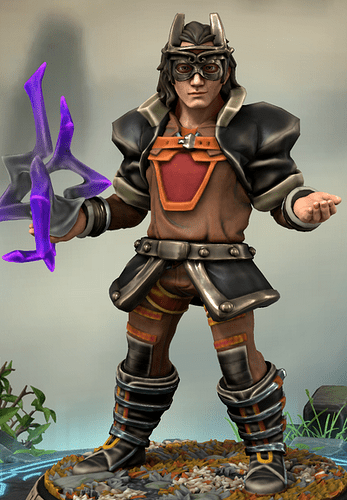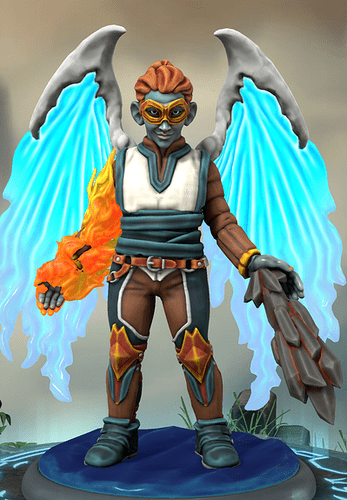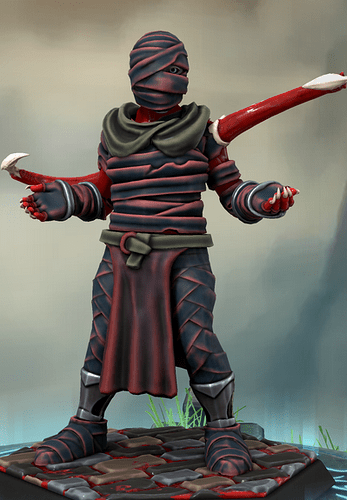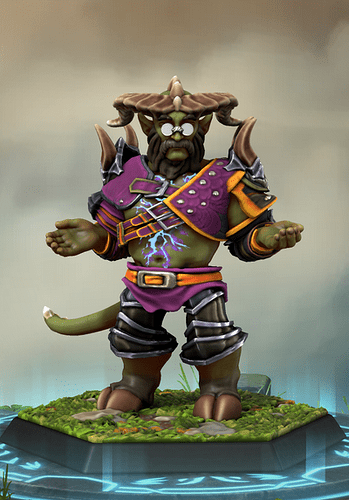Synseeker
Real Name: Garlach Realmwalker**, First Appearance:** Into the Green #358, April 1992
Lieutenant Type: Enemy
Die Size: d8
Motive: Obedience, Approach: Otherworldly
Traits:
- Fissure: As an action, Synseeker may roll his status die and Attack any number of targets. Then, destroy him and create a “Abyssal Portal” Challenge.
- Abyssal Portal: While this challenge is active, create a d8 “Abyssal Imp” minion at the star of each environment turn.
In the early 1990s, Greenheart’s ancient enemy Coven returned to prominence, leading to several major storylines in which she wielded increasingly horrifying arcane rites against the hero of the Green. Coven was still determined to claim the Green for herself, ascending to godhood as queen of the natural world, and was willing to use any means to accomplish her ends.
In 1992, Coven embarked on a new plan, to simply have the Green swallowed by a nightmare Realm over which she had influence. She believed that within that realm, Greenheart’s power would be broken, and she could sweep up the pieces for herself. To that end, she searched for an abyssal demon of moderate power, one who had a gift for breaking open portals between realms. She summoned this creature to her side, demanding his service and binding him with her dark power, and thus Synseeker entered the world.
Synseeker was not precisely what anyone had expected. Sarcastic, lugubrious, and prone to endless complaints about his working conditions, the unpleasantness of being punched through buildings on a regular basis, and the likelihood of Coven’s plans succeeding, he nonetheless followed the constraints of his bindings without attempts to subvert them. He entered Grovedale, using his powers to tear open portals to his abyssal realm – each time, his body was pulled apart and transformed into the magical structures of the gate, and his spirit returned home, to be summoned by Coven once again. As the portals weakened the fabric of reality and Synseeker was re-summoned again and again, Greenheart found herself chasing him around the city, desperately trying to close the portals faster than they could be opened.
In the end, of course, she succeeded, and Synseeker was banished. But Coven found his powers useful, and summoned him to her side again. With a sigh and a demand for more romance literature, which he considered to be the only positive product of this besunned realm, Synseeker became Coven’s reluctantly reliable right hand, the only being willing to tell her to her face when her plans were destined to fail while still being compelled to follow through on them. He became something of a sounding board and loyal opposition to the ancient witch, and she would come to admit that she was rather fond of him.
Not fond enough to release him from servitude, of course. But when Greenheart once tried to save him from his bindings, he simply shrugged. There were cruel masters aplenty in his realm. At least with this one, he got reading breaks, and it was entertaining to see how the latest plan would fail.
Behind the Scenes:
There was a huge Greenheart gap in my notes, and now it has been somewhat filled. Her Iron Age story launches with the Consul, and then she has to go to Japan and have some slightly awkward adventures there, but I didn’t really know what happens to her between about 1989 and the end of her solo comic in 1995.
Which seemed like a good time to give Coven a bit of a buff-up, and create a new semi-obedient demonic being. I’m going to be honest, the thing that pulled all this together was the tiny glasses. I love those tiny glasses.
Synseeker is an “extreme” demon, pulling himself apart to create shadow gates and then coming back to life, but he’s also kind of making fun of the whole concept at the same time. I suspect that’s what lets him survive the collapse that is coming up; he doesn’t have enough time to really establish himself within the realm of the extreme, but we’re getting close to the point where people start making fun of it and he’s perfectly suited for that.




